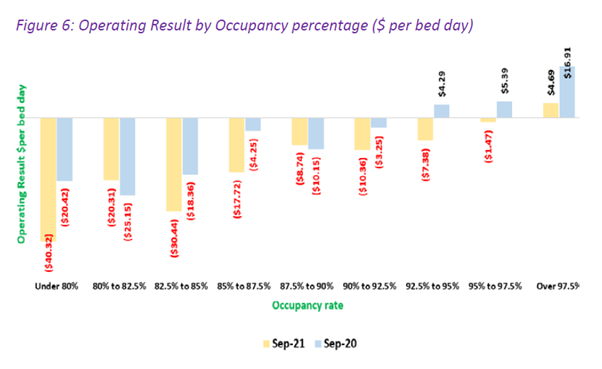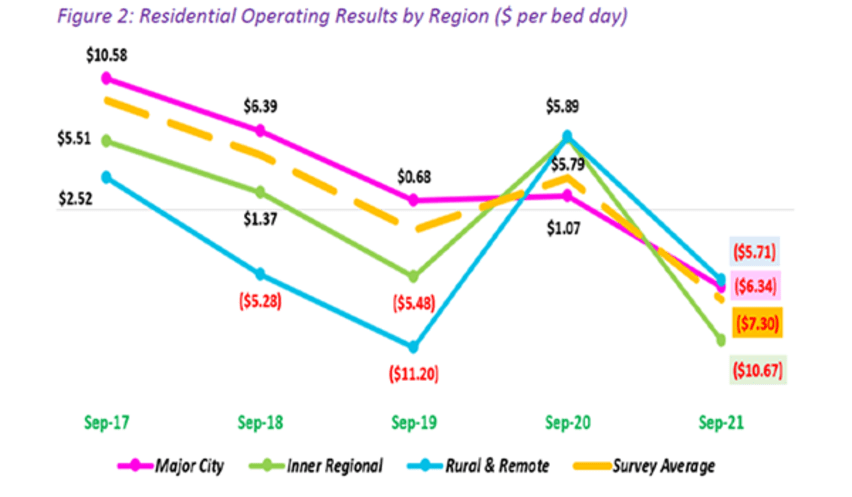Despite the $10 increase in the Basic Daily Fee, residential care providers have recorded an operating loss of $7.30 per bed per day in the first quarter of FY22. This was even before the highly transmissible Omicron variant saw a new wave of outbreaks in aged care homes, according to the results of the accounting firm’s delayed September 2021 Aged Care Financial Performance Survey.
The Survey findings – which incorporate data from 1,198 aged care homes (97,080 beds) and 56,223 Home Care Packages (HCPs) across Australia – show that 56% of homes made an operating loss, while 32% recorded an EBITDAR loss as COVID-19 funding (except to homes experiencing an outbreak) was cut from 1 July 2021.
In spite of the additional Basic Daily Fee supplement of $10 per bed day and the COPE (indexation) increase of 1.1% on the ACFI subsidy, the Superannuation Guarantee Scheme increase of 0.5%, workforce award increases ranging between 1.75% to 3.5%, and higher inflation (3.0% for the September quarter) all chewed into operators’ revenue.
Poor occupancy hits providers’ returns
Occupancy also played a major factor in the falling figures, dropping to 92% for mature homes and 90.7% nationally.
“We can see that the key to a return on residential care is occupancy,” StewartBrown Senior Partner Grant Corderoy said.
 Check out the graph to the right – as you can see, only homes above 92.5% occupancy were delivering a return in September 2020. In 2021, this jumped to only homes with 97.5% occupancy – well above the national average.
Check out the graph to the right – as you can see, only homes above 92.5% occupancy were delivering a return in September 2020. In 2021, this jumped to only homes with 97.5% occupancy – well above the national average.
This does not mean that homes will close, Grant added – but he said there will come a time when providers will have to look at whether they can continue supplementing loss-making homes, many of which are in regional and remote areas.
Occupancy impacted by growth in Home Care Packages
Occupancy is also likely to face continued headwinds – even after the current Omicron wave eases – as it is linked directly to the increase in the number of HCPs, which grew 5.9% over the quarter to over 186,000 Packages.
“There is a strong correlation between the increased number of HCPs and the reduction in residential occupancy, and this has a major effect on financial performance,” said Grant (pictured).
The Royal Commission’s recommendation that no person aged under 65 is to enter residential care also kicked in on 1 January, with all under-65s due to be moved out of residential care by 1 January 2025 – currently around 4,100, or 1.9% of aged care beds.
Given these results were collected prior to the current Omicron wave, StewartBrown also anticipates the results for December and March 2022 will be significantly worse until the variant is contained.
Significant funding reform required
What then is the solution?
Grant underlined the need for a number of financial reforms to be considered, including:
- Funding to increase staff remuneration and benefits
- Subsidy funding to directly correlate to direct costs of care (particularly staff)
- Regulated consumer contribution for Home Care (and CHSP) based on ability to pay
- Deregulation of residential Basic Daily Fee
- Structural enhancement of residential Accommodation Pricing model
- Alternate Home Care funding model
User pays the answer
“There has to be a co-contribution to care,” he argued, citing David Tune’s Aged Care Review which outlined how a co-contribution system could operate.
Home care also needs to be reformed to offer 10 to 12 levels of funding and collect consumer contributions, considering the mix of services, cost of services and what recipients want.
Grant also again advocated for a ‘deferred rental’ RAD – set at a lower price than a DAP – as a solution, pointing out that this would deliver operators a surplus of $11.41 per resident per day – even if only the unsupported residents were included.
“This is a really difficult part of the reform that hasn’t been considered,” he concluded.
Food for thought.
You can watch Grant’s presentation on the results here.










